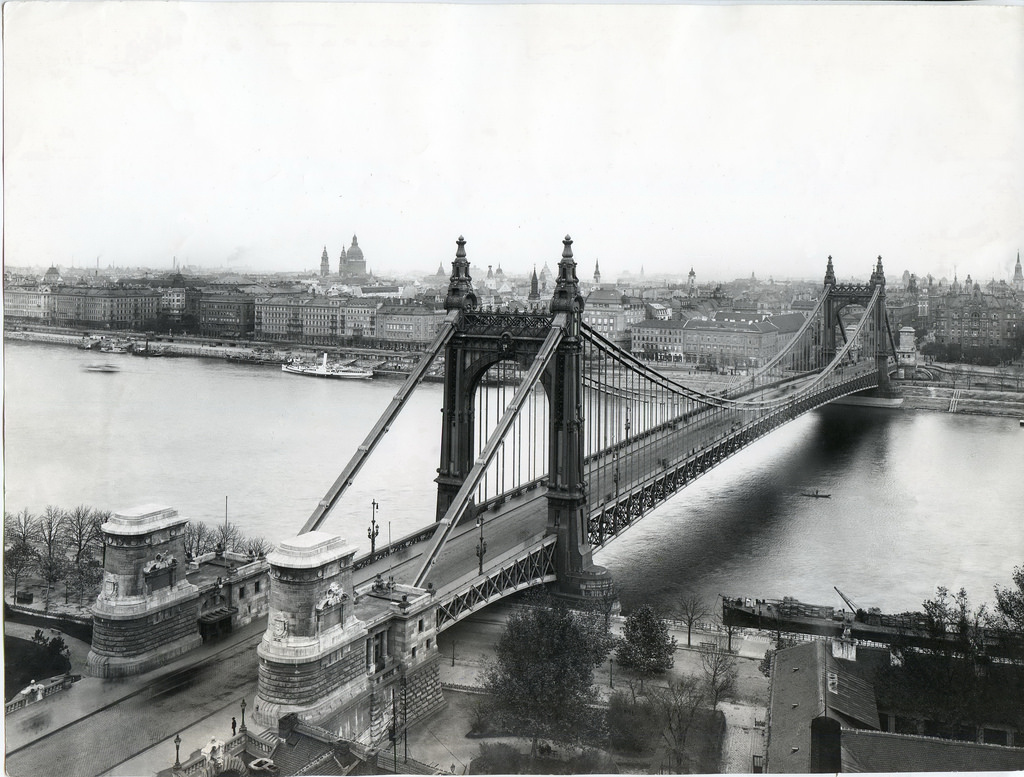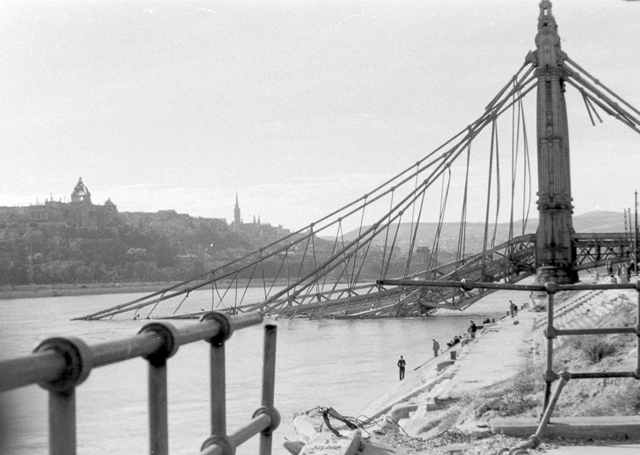We Recommend:
Bach Steel - Experts at historic truss bridge restoration.
BridgeHunter.com Phase 1 is released to the public! - Visit Now
Erzsébet híd (Elisabeth Bridge)

Primary Photographer(s): Nathan Holth
Bridge Documented: July 2, 2017
Budapest: Pest County, Central Hungary (Pest megye, Magyarország): Hungary (Magyarország)
Metal Plate Girder Stiffening Wire Cable Suspension, Fixed and Approach Spans: Metal Stringer (Multi-Beam), Fixed
1964 By Builder/Contractor: Ganz–MÁVAG and Engineer/Design: Sávoly Pál
Not Available or Not Applicable
951.4 Feet (290 Meters)
1,242.1 Feet (378.6 Meters)
Not Available
1 Main Span(s) and 2 Approach Span(s)
Not Applicable

View Information About HSR Ratings
Bridge Documentation
The Elisabeth Bridge (Erzsébet híd) stands out among bridges in Budapest because among the bridges destroyed in the city during the war, this is a bridge for which the pre-war design was not replicated. A photo of the previous bridge is shown above for comparison.
The original bridge was built in 1903, and it received significant attention in the engineering periodicals of the time. The bridge was an eyebar chain suspension bridge with rich ornamentation. The design and aesthetics of the bridge was purposely made to be different from other bridges in the city because it was felt that replicating the design of one of the other bridges would have been too monotonous. The war destroyed most of the bridge, with the exception of one tower and one adjacent backstay span. These ruins remained standing until a simple, modern wire cable suspension bridge with steel riveted towers and stiffening girders was erected in its place in 1964.
Above: Photo showing bridge construction.
Reportedly this bridge was designed with the aid of computers, which would have been an early use of computers for bridge design. Computers of the time reportedly were unable to calculate the design of the bridge using a traditional circular bundle for the main cable, therefore the main cable on this bridge takes on the form of a hexagon which was easier for the computers to handle.
The bridge is named after Wittelsbach Erzsébet (Empress Elisabeth of Austria).
The general contractor for the bridge is not listed, the company responsible for the cables on the bridge was Ganz–MÁVAG.
Above: View of the 1903 bridge.
Above: View of the 1903 bridge after destruction.
Above: View of the 1903 bridge after destruction.
Above: View of the 1903 bridge after destruction.
Above: Photo showing bridge construction.
![]()
Photo Galleries and Videos: Erzsébet híd (Elisabeth Bridge)
Bridge Photo-Documentation
Original / Full Size PhotosA collection of overview and detail photos. This gallery offers photos in the highest available resolution and file size in a touch-friendly popup viewer.
Alternatively, Browse Without Using Viewer
![]()
Bridge Photo-Documentation
Mobile Optimized PhotosA collection of overview and detail photos. This gallery features data-friendly, fast-loading photos in a touch-friendly popup viewer.
Alternatively, Browse Without Using Viewer
![]()
Maps and Links: Erzsébet híd (Elisabeth Bridge)
Coordinates (Latitude, Longitude):
Search For Additional Bridge Listings:
Additional Maps:
Google Streetview (If Available)
GeoHack (Additional Links and Coordinates)
Apple Maps (Via DuckDuckGo Search)
Apple Maps (Apple devices only)
Android: Open Location In Your Map or GPS App
Flickr Gallery (Find Nearby Photos)
Wikimedia Commons (Find Nearby Photos)
Directions Via Sygic For Android
Directions Via Sygic For iOS and Android Dolphin Browser








